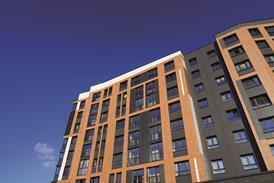The sheer weight of energy legislation that has been released in recent years has often led to project uncertainty and left many firms struggling to cope.
So here, with a comprehensive round-up of all relevant acts, directives and regulations is Martin Clowes, director of energy and building services engineer Elementa Consulting. And over the following 15 pages, he has compiled a sector-by-sector guide examining how recent legislation is bedding in, its relevance to each sector’s specific agenda and what is lying around the corner...
You must have been on another planet for the past year if you don’t know that energy and sustainability are the most talked about issues affecting the construction industry. As a nation we are running out of fossil fuel and internationally global warming is a fact, so legislation is inevitable until energy costs rise so much that people take their own action.
Measures such as Part L, PPS 22 and the Energy Performance of Buildings Directive attempt to close the loop between the design and construction process and the operation of buildings. However they have been forced on a largely unprepared industry, leading to genuine project uncertainty for many teams – from the client through to the building services engineers. The top teams will cope, because they do a lot of it already, but others may struggle until they have learned how.
Lack of understanding of the fundamentals is another major issue. Energy performance is now a real constraint on design. Doing it properly is an intellectual and behavioural challenge requiring most architects and engineers to work together in new ways. Part L 2006 is leading us there and more legislation is on the way. In fact, there is so much out there that it can be difficult to know which of the thousands of European directives, UK acts and codes of practice are relevant. So if you’re confused, read on for a round-up of the energy legislation that you need to know about …
ACTS
Sustainable and Secure Buildings Act 2005
Widens the potential scope of Building Regulations to include:
- Sustainable development
- Environmental protection
- Conservation of fuel and power
- Reduction of greenhouse gas emissions can require buildings to be upgraded:
- At change of occupancy
- When other work is carried out
Sustainable Energy Act 2003
Committing the government to setting a target for the use of combined heat and power generated electricity in the central government estate.
Warm Homes Energy Conservation Act 2000
Requires a strategy setting out local authority’s policies, ensuring the efficient use of energy; and preventing reasonably practicable persons from living in fuel poverty.
Home Energy Conservation Act 1998
Makes provision for local authorities to draw up energy conservation reports for residential accommodation in their areas including an assessment of the effect on carbon dioxide emissions.
Clean Air Act 1993 and Environment Act 1995
Established control zones and standards for ambient air quality. It is again relevant for biomass energy and waste-to-energy schemes, requires special consideration, calculation and probably modelling of flue gas emissions under an environmental impact assessment.
Workplace (Health, Safety and Welfare) Regulations 1992
It includes terms relating to comfort and ventilation.
Factories Act 1961
Defined minimum temperature standards in winter but not summer!
BUILDING REGULATIONS
Thermal building regulations:
- 1976 Introduced
- 1982 Updated with better fabric insulation
- 1990 Better insulation again
- 1995 Better insulation and SAP calculations
- 2002 Change of focus to carbon and some overheating provisions in non-domestic
- 2006 Elemental methods out. Change to target improvements in carbon consumption and national performance calculation methodology.
- Part F has been revised to bring it into line with the new Part L. It is a performance-based regulation but the approved document is full of complying options.
- Very specific as to mechanical and passive schemes
- Detailed provisions on background and purge ventilation
- Window opening characteristics affect window area. Mechanical ventilation rates are defined so Part F links to part L
- Allows mechanical or natural ventilation provided minimums are met
- Refers extensively to CIBSE documents
- Refers to part L2A for overheating
- Cross reference to part L needed
Part L – Conservation of Fuel and Power 2006
Application
- You need to consider the application of Part L for all new building work, unless contracts were entered into before 6 April 2006 and work starts before 1 October 2006, or notice/plans certificate accepted or full plans were approved pre 6 April 2006 and work starts pre 1 April 2007.
- To implement the EPBD, reduce energy use by 18+% compared with 2002 regulations, incentivise renewable technology and deal with existing buildings because of slow replacement.
Introduces the concepts of:
- Thermal elements – walls, floors and roofs
- Controlled fittings – windows, rooflights and doors
- Controlled services – lighting, heating, ventilation and air-conditioning equipment. Lifts etc are not included
- Low and zero carbon energy sources – help on applying these within the regulations framework is provided in a strategic guide
- Carbon emission calculations for dwellings
- National calculation methodologies required by EPBD are introduced; SAP 2005 for dwellings
- Carbon emission calculations for buildings other than dwellings
- BRE’s Simplified Building Energy Model (SBEM) is used. Other methodologies can be used but must be accredited.
- The software program must calculate the whole building CO2 emission rate in kg/m2 of the building per year. It uses data on building fabric, geometry plant and human activity patterns to do its calculations. It models the proposed building form, engineering services in a lot of detail. All this is combined with activity models. It then calculates:
- Target carbon emissions rate (TER), using Part L 2002 standards for a building of similar size and shape with an improvement factor (15-20%) plus a second improvement factor based on the provision of low and zero carbon (LZC) technologies (10%)
- Building emissions rate (BER) based on your actual proposals. If BER is less than TER you pass!
Part L1A – new dwellings
- Elemental methods are out, but limiting U-values is in
- Performance standards set in terms of dwelling energy rating and CO2 emissions
- Flexible techniques to achieve CO2 target emission (80% of 2002 dwellings having same envelope form and size)
- Non gas fossil fuels in effect disadvantaged
- Overheating limited by construction methods to minimise uptake of domestic air conditioners
- New SAP 2005 calculation and overheating methodology
- Air tightness standards mandatory but set at low performance level
- Testing of air tightness now required
- Thermal bridging now controlled via robust details and site inspection.
Part L1B – existing dwellings
- n Extensions – total area of windows, doors and roof windows must be less than 25% of the floor area and built from conforming glazing for floor, walls and doors
- n Conservatories less than 30 m2 are exempt
- n Larger conservatories or highly glazed extensions must be thermally separated from the dwelling and built with well insulated elements, fittings and complying services
- n Material changes of use – this collects most ways of changing the number of residences in a building and applies the thermal standards to elements, fittings and services.
- n Material alterations – works that make a building, fitting or service no longer either comply with requirements. The thermal requirements then kick in for elements, fittings and services. Work on services cannot get worse and should get better via a domestic heating compliance guide
- n Work is subject to a test of practicality, technical risk and cost effectiveness (15-year payback).
Part L2A – new buildings other than dwellings
Elemental method is out and SBEM methodology is in. Performance criteria are set and a compliance process is set out.
Criteria
- Design has an acceptable CO2 emission rate. The BER must be less than the TER. The TER is higher for air-conditioned buildings, which seems counter-intuitive, and it can be difficult to make a simple naturally ventilated building comply due to the low target.
- U-values and thermal bridging (robust details will be adopted by most teams to avoid more difficult calculations)
- Air permeability – the leakiness of a building as tested by pressurisation
- HVAC systems – this is regulated in considerable detail
- Lighting and lighting controls
- Energy metering
- Overheating in non-air-conditioned spaces
- Solar heat gains and internal occupation must not exceed 35 Watts per m2 averaged over a July day or the room should not exceed 28°C for a defined period.
- For the building fabric, a builder must have a suitable system of site inspection. Reporting by a “suitably qualified person” against accredited design details and the requirements of the SBEM design output is needed.
- For air permeability, all buildings of more than 500 m2 must be tested to Air Tightness Testing & Measurement Association standards with a report by a “suitably qualified person”. There are some relaxations available if a building fails before October 2007.
- Commissioning must be carried out and managed to defined standards and a report prepared by a “competent person”.
A building logbook, enabling the energy usage to be managed, must be provided. It is specifically stated that it should not be in the form of a typical operation and maintenance manual. The idea is that it should be rather concise, detailing what to do and how to do it.
Compliance check list
The regulation envisages that the developer will employ a “competent person” to compile a 22-point checklist of evidence to demonstrate compliance. The building control body has discretion to accept the competencies of individuals. The checklist confirms that the construction meets the requirements scheduled in the criteria above.
Part L2B – existing buildings other than dwellings
- Applies to extensions, installation alteration or renovation of thermal elements, controlled fittings and services
- Applies to fit-out works. In pre-2006 compliant shells, fit-out has to comply with the HVAC compliance guide. In compliant shells the fit-out has to comply with Part L2A checklist criteria for the shell. So the shell SBEM etc will have to transfer through to the fit-out.
- Consequential improvements apply if area of building is more than 1000 m2 and there is an extension, first provision or increase in capacity of services. but the improvements must be technically and economically feasible – 15-year payback based on defined energy costs. (It is not clear how building control is able to challenge proposals robustly so as to force work to be done). Historic buildings are not exempt
- The building envelope is subject to improvement provisions where elements are provided, replaced, retained or renovated
- Windows and doors which are to be provided or replaced must meet minimum standards
- Services standards cannot get worse than existing and should get better through use of a compliance guide
- Material alterations and change of use provisions for thermal elements, controlled fittings and services follow a similar methodology to L1B
- Log books are required as in L2A
OTHER LEGISLATION
Energy Performance of Buildings Directive (EPBD) 2003
Promotes energy efficiency in new and existing buildings using:
- n National performance calculation methodology (in Part L 2006)
- n Energy performance standards (in Part L 2006)
- n Incorporation of low and zero carbon systems (in Part L 2006)
- n Building performance certificates (to come)
- n Inspection regimes for boilers and HVAC plant (to come).
Planning Policy Statement 22 2004
PPS22 sets out the government’s policies for renewable energy, which planning authorities should pay regard to when preparing local development documents and when taking planning decisions.
Policies in this statement cover technologies such as onshore wind generation, hydro, photovoltaics, passive solar, biomass and energy crops, energy from waste (but not energy from mass incineration of domestic waste), and landfill and sewage gas. The principles for making decisions on waste management are set out in PPG10 (Planning and Waste Management) and Waste Strategy 2000.
The statement covers CHP developments, although, given that some CHP projects are fuelled by a renewable resource, a number of the policies set out here may be relevant.
Merton, in south London, was the first council to apply a rule stipulating that 10% of a development’s energy requirement be generated on site. Other councils including the Greater London Authority are adopting the policy at varying percentages. Some have a sliding scale increasing the renewable requirement over a period of years, others are going to 20% very soon.
The Department for Communities and Local Government now expects councils to require renewables on developments. Some high-density urban sites without the right geology are going to find it very difficult to achieve the requirement, so there will be restrictions on density and architectural form if say 20% and above is strictly enforced.
Types of legislation
Acts Primary legislation in the UK is via act of parliament. Acts of parliament can include provision for regulations or orders to be made within the framework of an act.
Regulations Regulations have the same force of law as acts, but are limited by the act under which they were enacted.
Standards and codes of practice Regulations often refer to European or British Standards or codes of practice as providing a way of conforming to regulations. Much more of these are included in new Building Regulations as second- and third-tier references.
Guides Other appropriate national standards, codes of practice and guides which may or may not be specifically mentioned in legislation, but which
cannot be ignored (such as the Health
and Safety Executive’s Legionella guidance).
European regulations European Commission regulations come into force in the UK as soon as they are published in the Official Journal of the European Union.
European directives The commission’s directives come into force in the UK only after changes to UK legislation.
Regulations August 2006
- 1
- 2
- 3
- 4
- 5
- 6
- 7
- 8
 Currently reading
Currently readingEnergy: an overview
- 9
- 10
- 11
- 12
- 13
- 14
- 15
- 16
- 17
- 18






































No comments yet